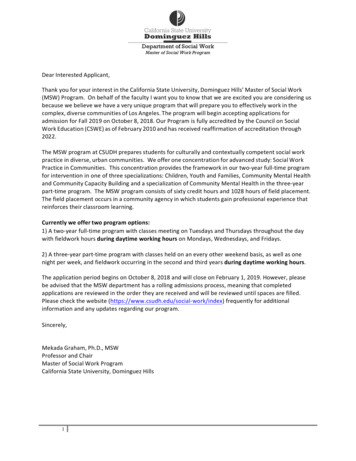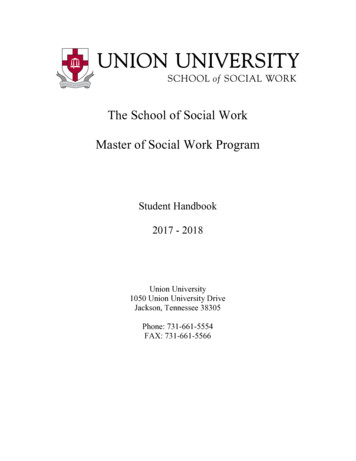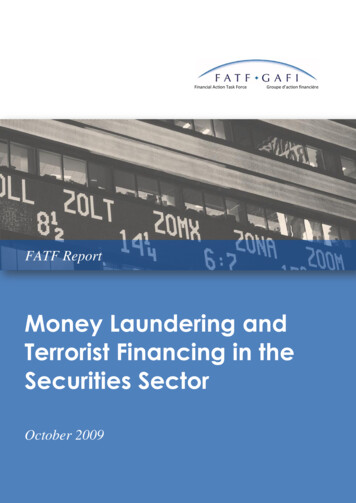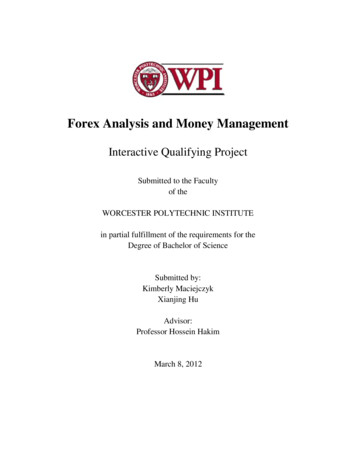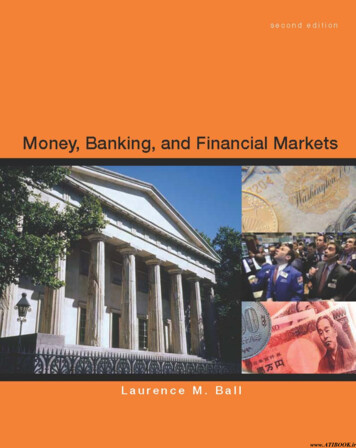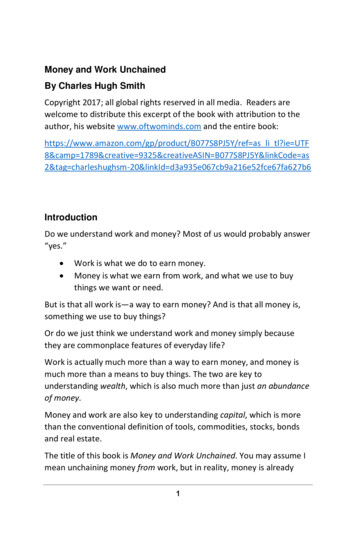
Transcription
Money and Work UnchainedBy Charles Hugh SmithCopyright 2017; all global rights reserved in all media. Readers arewelcome to distribute this excerpt of the book with attribution to theauthor, his website www.oftwominds.com and the entire ref as li tl?ie UTF8&camp 1789&creative 9325&creativeASIN B077S8PJ5Y&linkCode as2&tag charleshughsm-20&linkId d3a935e067cb9a216e52fce67fa627b6IntroductionDo we understand work and money? Most of us would probably answer“yes.” Work is what we do to earn money.Money is what we earn from work, and what we use to buythings we want or need.But is that all work is—a way to earn money? And is that all money is,something we use to buy things?Or do we just think we understand work and money simply becausethey are commonplace features of everyday life?Work is actually much more than a way to earn money, and money ismuch more than a means to buy things. The two are key tounderstanding wealth, which is also much more than just an abundanceof money.Money and work are also key to understanding capital, which is morethan the conventional definition of tools, commodities, stocks, bondsand real estate.The title of this book is Money and Work Unchained. You may assume Imean unchaining money from work, but in reality, money is already1
disconnected from work. Consider the following: if I borrow 1 billion at1% interest, and invest this money in a bond yielding 3% interest, Iwould earn 20 million annually (2% of 1 billion) just for typing a fewcomputer keystrokes.The privilege of borrowing a large sum of money at low interest ratesearned me the money, not my labor. Clearly, money is alreadyunchained from work.Work is also already unchained from money, as a great deal of usefulwork isn’t paid. Indeed, a large part of all the work performed on Earthisn’t paid.What we’ll be exploring is unchaining work from our preconceptions ofwork and unchaining money from our preconceptions of money. Byfreeing work and money from the shackles of our assumptions, we’refree to design a more productive, sustainable and fair society with amuch broader distribution of real wealth and capital.So why is it important to free money, work, wealth and capital from ourcurrent conceptual assumptions?The world has entered an age of accelerating automation that is rapidlyreplacing human labor. The common assumption is that this will freehumans from the burdens of work, and enable millions of people theluxuries of leisure and artistic expression. This is the dream embodiedby Universal Basic Income (UBI), the increasingly popular proposal togive everyone a monthly income without any strings attached.But where will the money come from to pay us all to no longer performproductive work?To infer that the money will come from automation’s profits or byborrowing the money from future taxpayers makes erroneousassumptions about the nature of money, profit and wealth.The danger is that if we don’t fully understand work, money, wealth andcapital, we may find ourselves in a behavioral sink of purposelessdespair with no income at all. Rather than entering a paradise of paid2
leisure, we might find ourselves in a nightmare of social dysfunctionthat extends far beyond financial destitution, deep into a toxic povertyof purpose and meaning.This book poses a thought experiment: let’s assume we don’t reallyunderstand work and money, and that we’ll discover their nature byasking a series of questions: What is work?What role does work play in human life?How is work connected to money, capital and wealth?Once we have a better understanding of work, where does thistake us?Then we’ll ask the same questions of money: What is money?What role does money play in human life?How is money connected to capital, wealth and work?Once we have a better understanding of money, where doesthis take us?We also need to investigate the connections between money, work,capital and wealth: What are the connections between work, money, capital andwealth?Once we understand the connections, where does this take us?The process of asking these questions reveals a startling truth: wenaturally assume our conceptions of work and money are like laws ofNature—that our concepts are reflections of immutable characteristicsof work and money.But the reality is that our concepts are not laws of Nature—they aresocial constructs. And once we reach a different understanding of workand money, we can adopt entirely different social constructs that willimprove our lives and communities in a sustainable fashion.3
4
Section One: WorkI. The Complex Wealth Created by WorkWhat is Work?What is work? The commonly accepted definition is “work is what wedo to earn money.” But since not all work is paid—a subject we’llexplore in the next section—in order to truly understand work, we haveto ask: other than its connection to money, what else sets work apartfrom the rest of human activity?We could start by noting the obvious: that work is different fromleisure. We know watching TV isn’t work, but what differentiateswatching TV from work? Our first answer is: work is what someone paysus to do. But this isn’t very helpful, as a great deal of work isn’t paid.Furthermore, it’s not always obvious whether an activity is leisure orwork.Very few people get paid to watch TV, and those few who are paid—TVcritics, for example—aren’t paid solely to watch TV; they’re paid toassess the content of the TV programs and prepare their assessment formedia distribution.Since nobody pays me to do yardwork around my own house, is that aleisure activity rather than work? But if I do the exact same task for myneighbor who pays me, then does this same activity becomes work?Take a craft hobby such as assembling a quilt or fashioning a piece offurniture. The process of making a quilt or cabinet as paid work is verysimilar to the hobbyists’ activity. If I give the cabinet I made away, thenmy labor was leisure, but if I sell it, then does my labor qualifies aswork?Clearly, commercial value has a role in certain kinds of work, but itdoesn’t help us understand the nature of work or what sets it apartfrom other activities.5
Work has a different structure than leisure. This may seem obvious, butwhat makes the same activity leisure in one setting and work inanother? It’s not simply a matter of getting paid.The working TV critic may appear to be no different than the personbeing entertained, but the process of assessing the program, comparingit to past series and competing offerings, is quite different from beingentertained.We can start by observing that work generates an output: some goal isreached, and the work yields some measurable value. In other words,work is focused on production rather than consumption. The productmay have utility value, i.e. it’s useful, or others may value the result forother reasons.By this definition, making a quilt or piece of furniture is clearly work,regardless of the commercial value of the finished item. Both haveutility value, as the quilt keeps us warm at night and the cabinet servesto store things. If the quilt and cabinet are well-made and attractive,they may also provide an aesthetic value to those using them.We all understand utility value and aesthetic value, but what otherkinds of value are created by work?Consider two swimmers in a pool. Both are doing the same activity, butone is swimming for enjoyment, while the other is training for a teamrace. The first activity is leisure, the second is something different thanleisure. But is it work? The swimmer who is training isn’t being paid, noris she producing a tangible item with utility or aesthetic value.Nonetheless, her training seems more like work than leisure. Thisexample illustrates that work has intangible, invisible qualities—in thisinstance, an intent and goal that sets it apart from leisure.The first swimmer’s intent and goal is to relax via a leisurely swim; theswim’s output isn’t being measured, and its value to others isn’t aconsideration. While others may derive some value from her choice totake a swim rather than enjoy some other form of leisure, that isn’t thegoal or organizing purpose of her swim.6
The point here is the value of an activity may be invisible to observers:the leisurely swimmer may place a high value on the relaxation andfitness benefits of her swim. Her swim may well benefit her familymembers and society via its health benefits, but this is quite differentfrom the value others place on the other swimmer’s training.The second swimmer’s intent and goal is to improve her lap time andendurance to increase her chances of winning team races, and this isthe organizing purpose of her swim. She may or may not enjoy her timein the water, but her pleasure isn’t the organizing purpose for theactivity; that is not why she is swimming, nor does it inform thestructure of her swimming.The first swimmer can stop whenever she chooses, or switch strokes atwhim; the organizing purpose of her swim is personal relaxation, andthat purpose defines the structure of her activity: she swims forwhatever time she chooses, and stops when her mental and physicalstate suits her.Her activity generates health benefits, but these don’t define thestructure of her leisurely swim. If improved health was the organizingpurpose, then the structure of her swim would include metrics such asher pulse rate increasing to a desired range, and her swim would haveto be of a minimal duration.In other words, if the organizing purpose is improving health in somemeasurable way, this requires an intentional, sustained effort andmeasuring the output of her activity.This is not to say that the value of the leisurely swimmer’s activity issomehow less than the value of the competitive swimmer’s workout,any more than the hobbyist’s furniture is less valuable than the paidcraftsperson’s furniture. The point is that work is structured differentlyfrom leisure; it has a different organizing purpose that requires a muchdifferent structure than leisure activities.There is another key difference between the leisurely swim and thetraining swim: the social value of each swimmers’ activity.7
The competitive swimmer’s time in the pool is structured not just toreach benchmarks such as faster lap times. Her membership on a teammeans that the organizing purpose of her time in the pool is to help herteam win competitions. The social value of the team is the coreorganizing purpose of her training. The team is not just individuals whohappen to compete on the same roster. The output of each member’straining has value to her teammates, her coach and the team’s sponsorsin ways that are different from the value that others derive from theleisurely swimmer’s time in the pool.Both swimmers generate social value. The leisurely swimmer’s physicaland mental health is improved, benefiting her family and friends, andlowering the odds of chronic lifestyle diseases that burden society withhigher costs of care.The competitive swimmer’s effort has value to a range of other peopleand institutions. If the swimmer’s training results in her winning keyraces, her career may advance; this is a personal gain. But her coach’scareer—and the monetary rewards that accrue to winning coaches—may also advance. The team accrues value from her winning races, asdo institutional backers of the team (a university or corporate sponsors,for example). Each member of the team gains value from her winningraces as well, as there is potential career/commercial value in belongingto a winning team.If her wins create a financially lucrative career in swimming, that resultwill also enhance the finances of her family.The point here is two-fold: many other people may obtain value fromeach swimmers’ efforts, and the social value created by their activity iscomplex and far-reaching. Secondly, the social value of the team effortis an integral part of the second swimmer’s organizing purpose and thestructure of her time in the pool. There is no equivalent formal socialvalue in the structure and organizing purpose of the leisurely swimmer’stime in the pool.8
The leisurely swimmer doesn’t enter the pool thinking, I’m doing this soI’ll be a better spouse, Mom and colleague as a result of being fitter andmore relaxed; the organizing purpose of her swim is private.The competitive swimmer enters the pool remembering her coach’sadvice and her role in the upcoming team competition. She may befeeling the sting of a loss resulting from her previous performance. Theorganizing purpose of her swim is social, i.e. the team’s collaborativeefforts to win competitions.One way to understand the difference is: the competitive swimmer isneeded by the team, coach and sponsors. The group needs thecompetitive swimmer’s best efforts and most diligent training. If thecompetitive swimmer shortens her training or slacks off, she has let theteam down.The leisurely swimmer has no comparative social need driving heractivity. She can leave the pool early, or skip a day without feeling shehas let someone else down. Nobody needs her to swim her best or bediligent about in her time in the pool.That being needed is the source of dignity and self-worth is poorlyunderstood in our socio-political-economic system. Yet this dynamic iscore to being human: we crave not just social connections and theaffection of others, but to be needed and valued. Contributing to apurpose greater than ourselves in ways that are valued is the glue thatbinds our most meaningful social relations.Being on the team gives the competitive swimmer a positive social role,a publicly recognizable identity in an organization that plays a role in thecommunity at large. In other words, being a team member is not onlyan internal state of belonging and awareness of being needed, it is asocial state in which others know that she is on the team and that thismembership is meaningful because it entails obligations to work hard,support her teammate
1% interest, and invest this money in a bond yielding 3% interest, I would earn 20 million annually (2% of 1 billion) just for typing a few computer keystrokes. The privilege of borrowing a large sum of money at low interest rates earned me the money, not my labor. Clearly, money is already unchained from work. Work is also already unchained from money, as a great deal of useful work isn’t .


